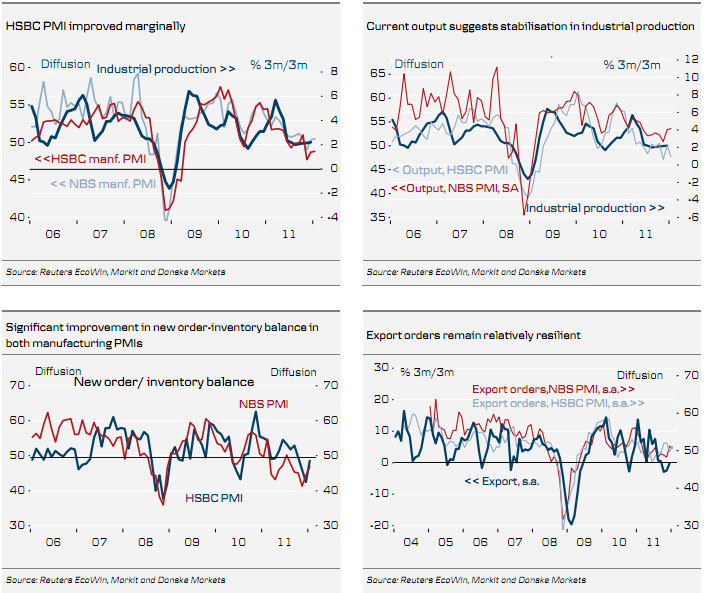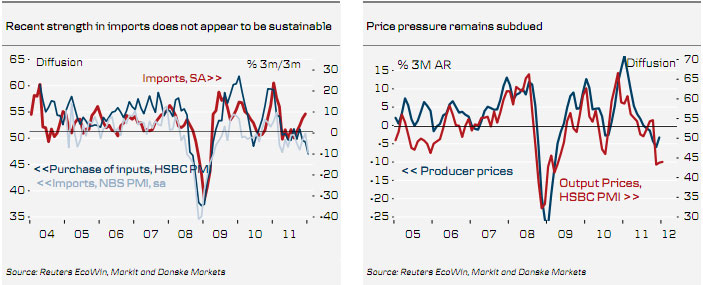China’s NBS manufacturing in January beat expectations and improved slightly from 50.3 to 50.5. The details are relatively strong with the new order inventory balance continuing to improve. So far there are no signs of a hard landing of the Chinese economy but, on a cautionary note, there are indications that China’s imports of particularly commodities could slow in the coming months despite some improvement in the overall economy.
The January manufacturing PMIs also improved in Japan, India, South Korea and Taiwan, suggesting that the global manufacturing cycle has started to turn.
Details
China’s official manufacturing PMI released by China’s National Bureau of Statistics improved slightly to 50.5 (consensus: 49.6, Danske Bank: 50.1) in January from 50.3 in December. In addition, there was no revision in connection with the release of the final estimate for the HSBC manufacturing in January. The HSBC manufacturing PMI in January improved marginally to 48.8 from 48.7 in December.
The details were relatively strong with new orders improving slightly from 49.8 to 50.4 and the finished goods inventory component declining substantially from 50.6 to 48.0. Hence, in line with the HSBC manufacturing PMI, the new order inventory balance improved markedly in January (see chart on next page). Export orders declined substantially from 48.6 to 46.9, but this appears to be largely due to seasonal distortions in the NBS PMI. Using our own seasonal adjustment export orders only declined marginally and stayed above 50 in line with export orders in the HSBC manufacturing PMI (see chart on next page).
On a negative note, there are signs that China’s imports could weaken in the coming months despite some improvement in the overall economy. As shown in the chart on the next page the import component dropped substantially in January. This is in line with the purchase of input component in the HSBC manufacturing PMI that in the past has been a reasonably successful predictor of China’s import growth. In our view the relatively strong imports of particularly commodities in recent months look unsustainable..
Manufacturing PMIs in Asia also improved outside China. In Japan the JMMA/Markit manufacturing PMI (released yesterday) improved from 50.2 to 50.7, in India the manufacturing PMI improved from 54.2 to 57.5, in South Korea it improved from 46.4 to 49.2 and finally in Taiwan it improved from 47.1 to 48.9.
Assessment & outlook
The manufacturing PMIs for January released in China and across the rest of Asia suggest that the global manufacturing cycle has started to turn. For China the message is that the economy appears to be stabilizing, but the level of the manufacturing PMIs still suggests that GDP growth will remain slightly below trend in Q1. This is broadly consistent with our view that GDP growth will improve slightly in Q1 12 but remain below trend. We expect the manufacturing PMIs to improve to the 52-53 range in the coming months.
The manufacturing PMIs certainly do not suggest that China is facing a hard landing and we expect the policy response to be very cautious in the coming months. The reserve requirement will be cut and fiscal policy will be eased slightly, but we do not expect a cut in the leading interest rates in China.

- English (UK)
- English (India)
- English (Canada)
- English (Australia)
- English (South Africa)
- English (Philippines)
- English (Nigeria)
- Deutsch
- Español (España)
- Español (México)
- Français
- Italiano
- Nederlands
- Português (Portugal)
- Polski
- Português (Brasil)
- Русский
- Türkçe
- العربية
- Ελληνικά
- Svenska
- Suomi
- עברית
- 日本語
- 한국어
- 简体中文
- 繁體中文
- Bahasa Indonesia
- Bahasa Melayu
- ไทย
- Tiếng Việt
- हिंदी
China: Slight Improvement in NBS PMI, No Signs of hard Landing
Published 02/01/2012, 09:47 AM
Updated 05/14/2017, 06:45 AM
China: Slight Improvement in NBS PMI, No Signs of hard Landing
3rd party Ad. Not an offer or recommendation by Investing.com. See disclosure here or
remove ads
.
Latest comments
Install Our App
Risk Disclosure: Trading in financial instruments and/or cryptocurrencies involves high risks including the risk of losing some, or all, of your investment amount, and may not be suitable for all investors. Prices of cryptocurrencies are extremely volatile and may be affected by external factors such as financial, regulatory or political events. Trading on margin increases the financial risks.
Before deciding to trade in financial instrument or cryptocurrencies you should be fully informed of the risks and costs associated with trading the financial markets, carefully consider your investment objectives, level of experience, and risk appetite, and seek professional advice where needed.
Fusion Media would like to remind you that the data contained in this website is not necessarily real-time nor accurate. The data and prices on the website are not necessarily provided by any market or exchange, but may be provided by market makers, and so prices may not be accurate and may differ from the actual price at any given market, meaning prices are indicative and not appropriate for trading purposes. Fusion Media and any provider of the data contained in this website will not accept liability for any loss or damage as a result of your trading, or your reliance on the information contained within this website.
It is prohibited to use, store, reproduce, display, modify, transmit or distribute the data contained in this website without the explicit prior written permission of Fusion Media and/or the data provider. All intellectual property rights are reserved by the providers and/or the exchange providing the data contained in this website.
Fusion Media may be compensated by the advertisers that appear on the website, based on your interaction with the advertisements or advertisers.
Before deciding to trade in financial instrument or cryptocurrencies you should be fully informed of the risks and costs associated with trading the financial markets, carefully consider your investment objectives, level of experience, and risk appetite, and seek professional advice where needed.
Fusion Media would like to remind you that the data contained in this website is not necessarily real-time nor accurate. The data and prices on the website are not necessarily provided by any market or exchange, but may be provided by market makers, and so prices may not be accurate and may differ from the actual price at any given market, meaning prices are indicative and not appropriate for trading purposes. Fusion Media and any provider of the data contained in this website will not accept liability for any loss or damage as a result of your trading, or your reliance on the information contained within this website.
It is prohibited to use, store, reproduce, display, modify, transmit or distribute the data contained in this website without the explicit prior written permission of Fusion Media and/or the data provider. All intellectual property rights are reserved by the providers and/or the exchange providing the data contained in this website.
Fusion Media may be compensated by the advertisers that appear on the website, based on your interaction with the advertisements or advertisers.
© 2007-2024 - Fusion Media Limited. All Rights Reserved.
